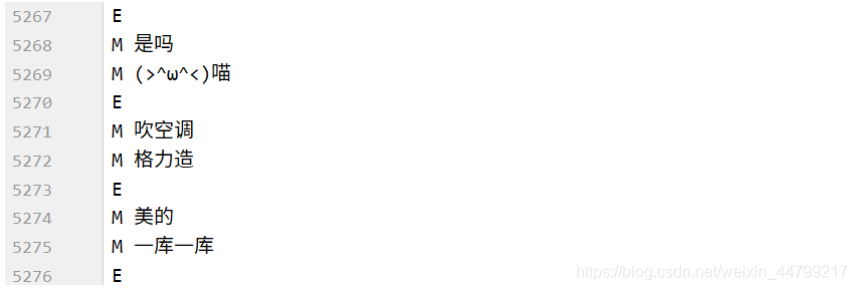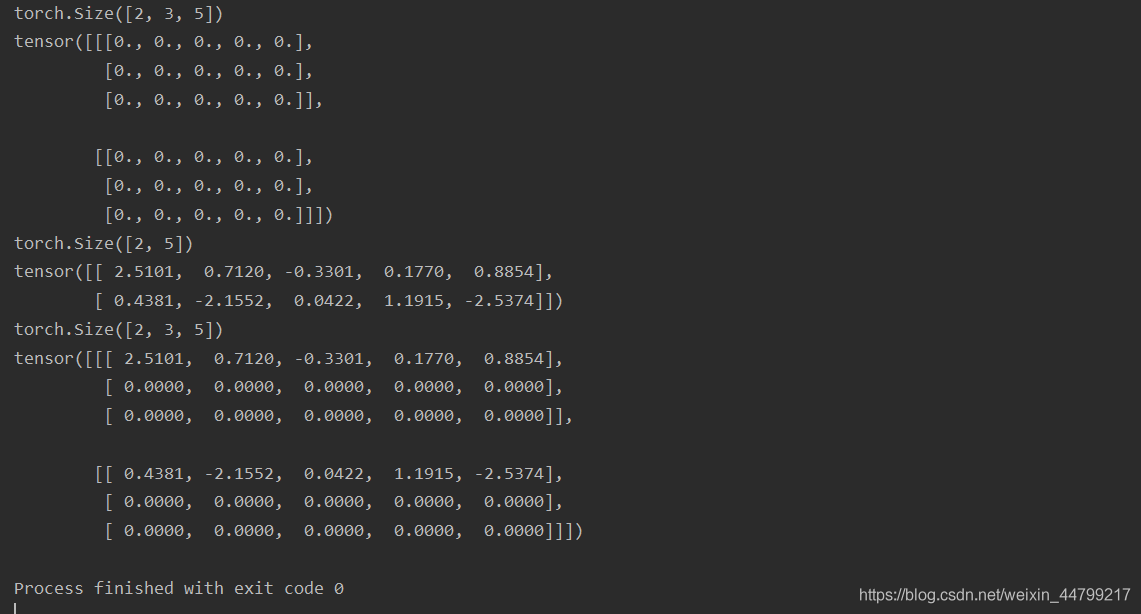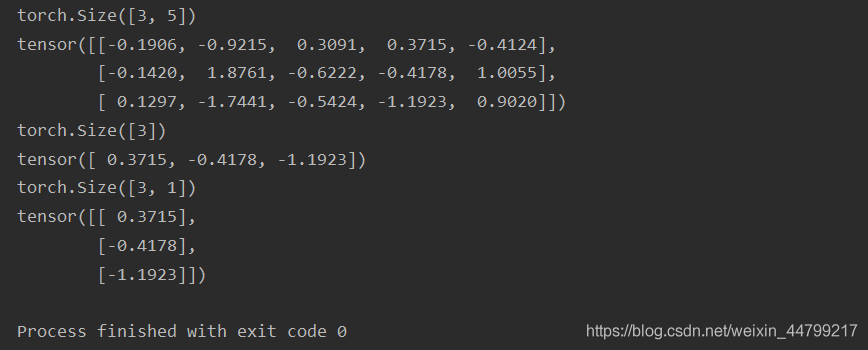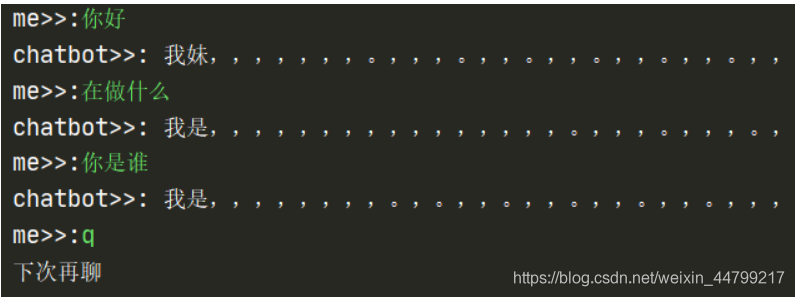python通過Seq2Seq實(shí)現(xiàn)閑聊機(jī)器人
主要的數(shù)據(jù)有兩個(gè):
1.小黃雞的聊天語料:噪聲很大

2.微博的標(biāo)題和評(píng)論:質(zhì)量相對(duì)較高

由于數(shù)據(jù)中存到大量的噪聲,可以對(duì)其進(jìn)行基礎(chǔ)的處理,然后分別把input和target使用兩個(gè)文件保存,即input中的第N行尾問,target的第N行為答
后續(xù)可能會(huì)把單個(gè)字作為特征(存放在input_word.txt),也可能會(huì)把詞語作為特征(input.txt)
2.1 小黃雞的語料的處理def format_xiaohuangji_corpus(word=False): '''處理小黃雞的語料''' if word:corpus_path = './chatbot/corpus/xiaohuangji50w_nofenci.conv'input_path = './chatbot/corpus/input_word.txt'output_path = './chatbot/corpus/output_word.txt' else: corpus_path = './chatbot/corpus/xiaohuangji50w_nofenci.conv'input_path = './chatbot/corpus/input.txt'output_path = './chatbot/corpus/output.txt' f_input = open(input_path, 'a') f_output = open(output_path, 'a') pair = [] for line in tqdm(open(corpus_path), ascii=True):if line.strip() == 'E': if not pair:continue else:assert len(pair) == 2, '長度必須是2'if len(pair[0].strip()) >= 1 and len(pair[1].strip()) >= 1: f_input.write(pair[0] + 'n') f_output.write(pair[1] + 'n')pair = []elif line.startswith('M'): line = line[1:] if word:pair.append(' '.join(list(line.strip()))) else:pair.append(' '.join(jieba_cut(line.strip())))2.2 微博語料的處理
def format_weibo(word=False): ''' 微博數(shù)據(jù)存在一些噪聲,未處理 :return: ''' if word:origin_input = './chatbot/corpus/stc_weibo_train_post'input_path = './chatbot/corpus/input_word.txt' origin_output = './chatbot/corpus/stc_weibo_train_response'output_path = './chatbot/corpus/output_word.txt' else:origin_input = './chatbot/corpus/stc_weibo_train_post'input_path = './chatbot/corpus/input.txt' origin_output = './chatbot/corpus/stc_weibo_train_response'output_path = './chatbot/corpus/output.txt' f_input = open(input_path, 'a') f_output = open(output_path, 'a') with open(origin_input) as in_o, open(origin_output) as out_o:for _in, _out in tqdm(zip(in_o, out_o), ascii=True): _in = _in.strip() _out = _out.strip() if _in.endswith(')') or _in.endswith('」') or _in.endswith(')'):_in = re.sub('(.*)|「.*?」|(.*?)', ' ', _in) _in = re.sub('我在.*?alink|alink|(.*?d+xd+.*?)|#|】|【|-+|_+|via.*?:*.*', ' ', _in) _in = re.sub('s+', ' ', _in) if len(_in) < 1 or len(_out) < 1:continue if word:_in = re.sub('s+', '', _in) # 轉(zhuǎn)化為一整行,不含空格_out = re.sub('s+', '', _out)if len(_in) >= 1 and len(_out) >= 1: f_input.write(' '.join(list(_in)) + 'n') f_output.write(' '.join(list(_out)) + 'n') else:if len(_in) >= 1 and len(_out) >= 1: f_input.write(_in.strip() + 'n') f_output.write(_out.strip() + 'n') f_input.close() f_output.close()2.3 處理后的結(jié)果

和之前的操作相同,需要把文本能轉(zhuǎn)化為數(shù)字,同時(shí)還需實(shí)現(xiàn)方法把數(shù)字轉(zhuǎn)化為文本
示例代碼:
import configimport pickle class Word2Sequence(): UNK_TAG = 'UNK' PAD_TAG = 'PAD' SOS_TAG = 'SOS' EOS_TAG = 'EOS' UNK = 0 PAD = 1 SOS = 2 EOS = 3 def __init__(self):self.dict = { self.UNK_TAG: self.UNK, self.PAD_TAG: self.PAD, self.SOS_TAG: self.SOS, self.EOS_TAG: self.EOS}self.count = {}self.fited = False def to_index(self, word):'''word -> index'''assert self.fited == True, '必須先進(jìn)行fit操作'return self.dict.get(word, self.UNK) def to_word(self, index):'''index -> word'''assert self.fited, '必須先進(jìn)行fit操作'if index in self.inversed_dict: return self.inversed_dict[index]return self.UNK_TAG def __len__(self):return len(self.dict) def fit(self, sentence):''':param sentence:[word1,word2,word3]:param min_count: 最小出現(xiàn)的次數(shù):param max_count: 最大出現(xiàn)的次數(shù):param max_feature: 總詞語的最大數(shù)量:return:'''for a in sentence: if a not in self.count:self.count[a] = 0 self.count[a] += 1 self.fited = True def build_vocab(self, min_count=1, max_count=None, max_feature=None): # 比最小的數(shù)量大和比最大的數(shù)量小的需要if min_count is not None: self.count = {k: v for k, v in self.count.items() if v >= min_count}if max_count is not None: self.count = {k: v for k, v in self.count.items() if v <= max_count} # 限制最大的數(shù)量if isinstance(max_feature, int): count = sorted(list(self.count.items()), key=lambda x: x[1]) if max_feature is not None and len(count) > max_feature:count = count[-int(max_feature):] for w, _ in count:self.dict[w] = len(self.dict)else: for w in sorted(self.count.keys()):self.dict[w] = len(self.dict) # 準(zhǔn)備一個(gè)index->word的字典self.inversed_dict = dict(zip(self.dict.values(), self.dict.keys())) def transform(self, sentence, max_len=None, add_eos=False):'''實(shí)現(xiàn)吧句子轉(zhuǎn)化為數(shù)組(向量):param sentence::param max_len::return:'''assert self.fited, '必須先進(jìn)行fit操作' r = [self.to_index(i) for i in sentence]if max_len is not None: if max_len > len(sentence):if add_eos: r += [self.EOS] + [self.PAD for _ in range(max_len - len(sentence) - 1)]else: r += [self.PAD for _ in range(max_len - len(sentence))] else:if add_eos: r = r[:max_len - 1] r += [self.EOS]else: r = r[:max_len]else: if add_eos:r += [self.EOS]# print(len(r),r)return r def inverse_transform(self, indices):'''實(shí)現(xiàn)從數(shù)組 轉(zhuǎn)化為 向量:param indices: [1,2,3....]:return:[word1,word2.....]'''sentence = []for i in indices: word = self.to_word(i) sentence.append(word)return sentence # 之后導(dǎo)入該word_sequence使用word_sequence = pickle.load(open('./pkl/ws.pkl', 'rb')) if not config.use_word else pickle.load( open('./pkl/ws_word.pkl', 'rb')) if __name__ == ’__main__’: from word_sequence import Word2Sequence from tqdm import tqdm import pickle word_sequence = Word2Sequence() # 詞語級(jí)別 input_path = '../corpus/input.txt' target_path = '../corpus/output.txt' for line in tqdm(open(input_path).readlines()):word_sequence.fit(line.strip().split()) for line in tqdm(open(target_path).readlines()):word_sequence.fit(line.strip().split()) # 使用max_feature=5000個(gè)數(shù)據(jù) word_sequence.build_vocab(min_count=5, max_count=None, max_feature=5000) print(len(word_sequence)) pickle.dump(word_sequence, open('./pkl/ws.pkl', 'wb'))
word_sequence.py:
class WordSequence(object): PAD_TAG = ’PAD’ # 填充標(biāo)記 UNK_TAG = ’UNK’ # 未知詞標(biāo)記 SOS_TAG = ’SOS’ # start of sequence EOS_TAG = ’EOS’ # end of sequence PAD = 0 UNK = 1 SOS = 2 EOS = 3 def __init__(self):self.dict = { self.PAD_TAG: self.PAD, self.UNK_TAG: self.UNK, self.SOS_TAG: self.SOS, self.EOS_TAG: self.EOS}self.count = {} # 保存詞頻詞典self.fited = False def to_index(self, word):'''word --> index:param word::return:'''assert self.fited == True, '必須先進(jìn)行fit操作'return self.dict.get(word, self.UNK) def to_word(self, index):'''index -- > word:param index::return:'''assert self.fited, ’必須先進(jìn)行fit操作’if index in self.inverse_dict: return self.inverse_dict[index]return self.UNK_TAG def fit(self, sentence):'''傳入句子,統(tǒng)計(jì)詞頻:param sentence::return:'''for word in sentence: # 對(duì)word出現(xiàn)的頻率進(jìn)行統(tǒng)計(jì),當(dāng)word不在sentence時(shí),返回值是0,當(dāng)word在sentence中時(shí),返回+1,以此進(jìn)行累計(jì)計(jì)數(shù) # self.count[word] = self.dict.get(word, 0) + 1 if word not in self.count:self.count[word] = 0 self.count[word] += 1self.fited = True def build_vocab(self, min_count=2, max_count=None, max_features=None):'''構(gòu)造詞典:param min_count:最小詞頻:param max_count: 最大詞頻:param max_features: 詞典中詞的數(shù)量:return:'''# self.count.pop(key),和del self.count[key] 無法在遍歷self.count的同時(shí)進(jìn)行刪除key.因此淺拷貝temp后對(duì)temp遍歷并刪除self.counttemp = self.count.copy()for key in temp: cur_count = self.count.get(key, 0) # 當(dāng)前詞頻 if min_count is not None:if cur_count < min_count: del self.count[key] if max_count is not None:if cur_count > max_count: del self.count[key] if max_features is not None:self.count = dict(sorted(list(self.count.items()), key=lambda x: x[1], reversed=True)[:max_features])for key in self.count: self.dict[key] = len(self.dict)# 準(zhǔn)備一個(gè)index-->word的字典self.inverse_dict = dict(zip(self.dict.values(), self.dict.keys())) def transforms(self, sentence, max_len=10, add_eos=False):'''把sentence轉(zhuǎn)化為序列:param sentence: 傳入的句子:param max_len: 句子的最大長度:param add_eos: 是否添加結(jié)束符add_eos : True時(shí),輸出句子長度為max_len + 1add_eos : False時(shí),輸出句子長度為max_len:return:'''assert self.fited, ’必須先進(jìn)行fit操作!’if len(sentence) > max_len: sentence = sentence[:max_len]# 提前計(jì)算句子長度,實(shí)現(xiàn)ass_eos后,句子長度統(tǒng)一sentence_len = len(sentence)# sentence[1,3,4,5,UNK,EOS,PAD,....]if add_eos: sentence += [self.EOS_TAG]if sentence_len < max_len: # 句子長度不夠,用PAD來填充 sentence += (max_len - sentence_len) * [self.PAD_TAG]# 對(duì)于新出現(xiàn)的詞采用特殊標(biāo)記result = [self.dict.get(i, self.UNK) for i in sentence] return result def invert_transform(self, indices):'''序列轉(zhuǎn)化為sentence:param indices::return:'''# return [self.inverse_dict.get(i, self.UNK_TAG) for i in indices]result = []for i in indices: if self.inverse_dict[i] == self.EOS_TAG:break result.append(self.inverse_dict.get(i, self.UNK_TAG))return result def __len__(self):return len(self.dict) if __name__ == ’__main__’: num_sequence = WordSequence() print(num_sequence.dict) str1 = [’中國’, ’您好’, ’我愛你’, ’中國’, ’我愛你’, ’北京’] num_sequence.fit(str1) num_sequence.build_vocab() print(num_sequence.transforms(str1)) print(num_sequence.dict) print(num_sequence.inverse_dict) print(num_sequence.invert_transform([5, 4])) # 這兒要傳列表
運(yùn)行結(jié)果:

創(chuàng)建dataset.py 文件,準(zhǔn)備數(shù)據(jù)集
import configimport torchfrom torch.utils.data import Dataset, DataLoaderfrom word_sequence import WordSequence class ChatDataset(Dataset): def __init__(self):self.input_path = config.chatbot_input_pathself.target_path = config.chatbot_target_pathself.input_lines = open(self.input_path, encoding=’utf-8’).readlines()self.target_lines = open(self.target_path, encoding=’utf-8’).readlines()assert len(self.input_lines) == len(self.target_lines), ’input和target長度不一致’ def __getitem__(self, item):input = self.input_lines[item].strip().split()target = self.target_lines[item].strip().split()if len(input) == 0 or len(target) == 0: input = self.input_lines[item + 1].strip().split() target = self.target_lines[item + 1].strip().split()# 此處句子的長度如果大于max_len,那么應(yīng)該返回max_leninput_length = min(len(input), config.max_len)target_length = min(len(target), config.max_len)return input, target, input_length, target_length def __len__(self):return len(self.input_lines) def collate_fn(batch): # 1.排序 batch = sorted(batch, key=lambda x: x[2], reversed=True) input, target, input_length, target_length = zip(*batch) # 2.進(jìn)行padding的操作 input = torch.LongTensor([WordSequence.transform(i, max_len=config.max_len) for i in input]) target = torch.LongTensor([WordSequence.transforms(i, max_len=config.max_len, add_eos=True) for i in target]) input_length = torch.LongTensor(input_length) target_length = torch.LongTensor(target_length) return input, target, input_length, target_length data_loader = DataLoader(dataset=ChatDataset(), batch_size=config.batch_size, shuffle=True, collate_fn=collate_fn, drop_last=True) if __name__ == ’__main__’: print(len(data_loader)) for idx, (input, target, input_length, target_length) in enumerate(data_loader):print(idx)print(input)print(target)print(input_length)print(target_length)五、完成encoder編碼器邏輯
encode.py:
import torch.nn as nnimport configfrom torch.nn.utils.rnn import pad_packed_sequence, pack_padded_sequence class Encoder(nn.Module): def __init__(self):super(Encoder, self).__init__()# torch.nn.Embedding(num_embeddings詞典大小即不重復(fù)詞數(shù),embedding_dim單個(gè)詞用多長向量表示)self.embedding = nn.Embedding( num_embeddings=len(config.word_sequence.dict), embedding_dim=config.embedding_dim, padding_idx=config.word_sequence.PAD)self.gru = nn.GRU( input_size=config.embedding_dim, num_layers=config.num_layer, hidden_size=config.hidden_size, bidirectional=False, batch_first=True) def forward(self, input, input_length):''':param input: [batch_size, max_len]:return:'''embedded = self.embedding(input) # embedded [batch_size, max_len, embedding_dim]# 加速循環(huán)過程embedded = pack_padded_sequence(embedded, input_length, batch_first=True) # 打包out, hidden = self.gru(embedded)out, out_length = pad_packed_sequence(out, batch_first=True, padding_value=config.num_sequence.PAD) # 解包 # hidden即h_n [num_layer*[1/2],batchsize, hidden_size]# out : [batch_size, seq_len/max_len, hidden_size]return out, hidden, out_length if __name__ == ’__main__’: from dataset import data_loader encoder = Encoder() print(encoder) for input, target, input_length, target_length in data_loader:out, hidden, out_length = encoder(input, input_length)print(input.size())print(out.size())print(hidden.size())print(out_length)break六、完成decoder解碼器的邏輯
decode.py:
import torchimport torch.nn as nnimport configimport torch.nn.functional as Ffrom word_sequence import WordSequence class Decode(nn.Module): def __init__(self):super().__init__()self.max_seq_len = config.max_lenself.vocab_size = len(WordSequence)self.embedding_dim = config.embedding_dimself.dropout = config.dropout self.embedding = nn.Embedding(num_embeddings=self.vocab_size, embedding_dim=self.embedding_dim, padding_idx=WordSequence.PAD)self.gru = nn.GRU(input_size=self.embedding_dim, hidden_size=config.hidden_size, num_layers=1, batch_first=True, dropout=self.dropout)self.log_softmax = nn.LogSoftmax()self.fc = nn.Linear(config.hidden_size, self.vocab_size) def forward(self, encoder_hidden, target, target_length):# encoder_hidden [batch_size,hidden_size]# target [batch_size,seq-len]decoder_input = torch.LongTensor([[WordSequence.SOS]] * config.batch_size).to(config.device)decoder_outputs = torch.zeros(config.batch_size, config.max_len, self.vocab_size).to( config.device) # [batch_size,seq_len,14] decoder_hidden = encoder_hidden # [batch_size,hidden_size] for t in range(config.max_len): decoder_output_t, decoder_hidden = self.forward_step(decoder_input, decoder_hidden) decoder_outputs[:, t, :] = decoder_output_t value, index = torch.topk(decoder_output_t, 1) # index [batch_size,1] decoder_input = indexreturn decoder_outputs, decoder_hidden def forward_step(self, decoder_input, decoder_hidden):''':param decoder_input:[batch_size,1]:param decoder_hidden:[1,batch_size,hidden_size]:return:[batch_size,vocab_size],decoder_hidden:[1,batch_size,didden_size]'''embeded = self.embedding(decoder_input) # embeded: [batch_size,1 , embedding_dim]out, decoder_hidden = self.gru(embeded, decoder_hidden) # out [1, batch_size, hidden_size]out = out.squeeze(0)out = F.log_softmax(self.fc(out), dim=1) # [batch_Size, vocab_size]out = out.squeeze(0)# print('out size:',out.size(),decoder_hidden.size())return out, decoder_hidden
關(guān)于 decoder_outputs[:,t,:] = decoder_output_t的演示
decoder_outputs 形狀 [batch_size, seq_len, vocab_size]decoder_output_t 形狀[batch_size, vocab_size]
示例代碼:
import torch a = torch.zeros((2, 3, 5))print(a.size())print(a) b = torch.randn((2, 5))print(b.size())print(b) a[:, 0, :] = bprint(a.size())print(a)
運(yùn)行結(jié)果:

關(guān)于torch.topk, torch.max(),torch.argmax()
value, index = torch.topk(decoder_output_t , k = 1)decoder_output_t [batch_size, vocab_size]
示例代碼:
import torch a = torch.randn((3, 5))print(a.size())print(a) values, index = torch.topk(a, k=1)print(values)print(index)print(index.size()) values, index = torch.max(a, dim=-1)print(values)print(index)print(index.size()) index = torch.argmax(a, dim=-1)print(index)print(index.size()) index = a.argmax(dim=-1)print(index)print(index.size())
運(yùn)行結(jié)果:

若使用teacher forcing ,將采用下次真實(shí)值作為下個(gè)time step的輸入
# 注意unsqueeze 相當(dāng)于淺拷貝,不會(huì)對(duì)原張量進(jìn)行修改 decoder_input = target[:,t].unsqueeze(-1) target 形狀 [batch_size, seq_len] decoder_input 要求形狀[batch_size, 1]
示例代碼:
import torch a = torch.randn((3, 5))print(a.size())print(a) b = a[:, 3]print(b.size())print(b)c = b.unsqueeze(-1)print(c.size())print(c)
運(yùn)行結(jié)果:

seq2seq.py:
import torchimport torch.nn as nn class Seq2Seq(nn.Module): def __init__(self, encoder, decoder):super(Seq2Seq, self).__init__()self.encoder = encoderself.decoder = decoder def forward(self, input, target, input_length, target_length):encoder_outputs, encoder_hidden = self.encoder(input, input_length)decoder_outputs, decoder_hidden = self.decoder(encoder_hidden, target, target_length)return decoder_outputs, decoder_hidden def evaluation(self, inputs, input_length):encoder_outputs, encoder_hidden = self.encoder(inputs, input_length)decoded_sentence = self.decoder.evaluation(encoder_hidden)return decoded_sentence八、完成訓(xùn)練邏輯
為了加速訓(xùn)練,可以考慮在gpu上運(yùn)行,那么在我們自頂一個(gè)所以的tensor和model都需要轉(zhuǎn)化為CUDA支持的類型。
當(dāng)前的數(shù)據(jù)量為500多萬條,在GTX1070(8G顯存)上訓(xùn)練,大概需要90分一個(gè)epoch,耐心的等待吧
train.py:
import torchimport configfrom torch import optimimport torch.nn as nnfrom encode import Encoderfrom decode import Decoderfrom seq2seq import Seq2Seqfrom dataset import data_loader as train_dataloaderfrom word_sequence import WordSequence encoder = Encoder()decoder = Decoder()model = Seq2Seq(encoder, decoder) # device在config文件中實(shí)現(xiàn)model.to(config.device) print(model) model.load_state_dict(torch.load('model/seq2seq_model.pkl'))optimizer = optim.Adam(model.parameters())optimizer.load_state_dict(torch.load('model/seq2seq_optimizer.pkl'))criterion = nn.NLLLoss(ignore_index=WordSequence.PAD, reduction='mean') def get_loss(decoder_outputs, target): target = target.view(-1) # [batch_size*max_len] decoder_outputs = decoder_outputs.view(config.batch_size * config.max_len, -1) return criterion(decoder_outputs, target) def train(epoch): for idx, (input, target, input_length, target_len) in enumerate(train_dataloader):input = input.to(config.device)target = target.to(config.device)input_length = input_length.to(config.device)target_len = target_len.to(config.device) optimizer.zero_grad()##[seq_len,batch_size,vocab_size] [batch_size,seq_len]decoder_outputs, decoder_hidden = model(input, target, input_length, target_len)loss = get_loss(decoder_outputs, target)loss.backward()optimizer.step() print(’Train Epoch: {} [{}/{} ({:.0f}%)]tLoss: {:.6f}’.format( epoch, idx * len(input), len(train_dataloader.dataset), 100. * idx / len(train_dataloader), loss.item())) torch.save(model.state_dict(), 'model/seq2seq_model.pkl')torch.save(optimizer.state_dict(), ’model/seq2seq_optimizer.pkl’) if __name__ == ’__main__’: for i in range(10):train(i)
訓(xùn)練10個(gè)epoch之后的效果如下,可以看出損失依然很高:
Train Epoch: 9 [2444544/4889919 (50%)]Loss: 4.923604Train Epoch: 9 [2444800/4889919 (50%)]Loss: 4.364594Train Epoch: 9 [2445056/4889919 (50%)]Loss: 4.613254Train Epoch: 9 [2445312/4889919 (50%)]Loss: 4.143538Train Epoch: 9 [2445568/4889919 (50%)]Loss: 4.412729Train Epoch: 9 [2445824/4889919 (50%)]Loss: 4.516526Train Epoch: 9 [2446080/4889919 (50%)]Loss: 4.124945Train Epoch: 9 [2446336/4889919 (50%)]Loss: 4.777015Train Epoch: 9 [2446592/4889919 (50%)]Loss: 4.358538Train Epoch: 9 [2446848/4889919 (50%)]Loss: 4.513412Train Epoch: 9 [2447104/4889919 (50%)]Loss: 4.202757Train Epoch: 9 [2447360/4889919 (50%)]Loss: 4.589584九、評(píng)估邏輯
decoder 中添加評(píng)估方法
def evaluate(self, encoder_hidden): ''' 評(píng)估, 和fowward邏輯類似 :param encoder_hidden: encoder最后time step的隱藏狀態(tài) [1, batch_size, hidden_size] :return: ''' batch_size = encoder_hidden.size(1) # 初始化一個(gè)[batch_size, 1]的SOS張量,作為第一個(gè)time step的輸出 decoder_input = torch.LongTensor([[config.target_ws.SOS]] * batch_size).to(config.device) # encoder_hidden 作為decoder第一個(gè)時(shí)間步的hidden [1, batch_size, hidden_size] decoder_hidden = encoder_hidden # 初始化[batch_size, seq_len, vocab_size]的outputs 拼接每個(gè)time step結(jié)果 decoder_outputs = torch.zeros((batch_size, config.chatbot_target_max_len, self.vocab_size)).to(config.device) # 初始化一個(gè)空列表,存儲(chǔ)每次的預(yù)測(cè)序列 predict_result = [] # 對(duì)每個(gè)時(shí)間步進(jìn)行更新 for t in range(config.chatbot_target_max_len): decoder_output_t, decoder_hidden = self.forward_step(decoder_input, decoder_hidden) # 拼接每個(gè)time step,decoder_output_t [batch_size, vocab_size] decoder_outputs[:, t, :] = decoder_output_t # 由于是評(píng)估,需要每次都獲取預(yù)測(cè)值 index = torch.argmax(decoder_output_t, dim = -1) # 更新下一時(shí)間步的輸入 decoder_input = index.unsqueeze(1) # 存儲(chǔ)每個(gè)時(shí)間步的預(yù)測(cè)序列 predict_result.append(index.cpu().detach().numpy()) # [[batch], [batch]...] ->[seq_len, vocab_size] # 結(jié)果轉(zhuǎn)換為ndarry,每行是一個(gè)預(yù)測(cè)結(jié)果即單個(gè)字對(duì)應(yīng)的索引, 所有行為seq_len長度 predict_result = np.array(predict_result).transpose() # (batch_size, seq_len)的array return decoder_outputs, predict_result
eval.py
import torchimport torch.nn as nnimport torch.nn.functional as Ffrom dataset import get_dataloaderimport configimport numpy as npfrom Seq2Seq import Seq2SeqModelimport osfrom tqdm import tqdm model = Seq2SeqModel().to(config.device)if os.path.exists(’./model/chatbot_model.pkl’): model.load_state_dict(torch.load(’./model/chatbot_model.pkl’)) def eval(): model.eval() loss_list = [] test_data_loader = get_dataloader(train = False) with torch.no_grad():bar = tqdm(test_data_loader, desc = ’testing’, total = len(test_data_loader))for idx, (input, target, input_length, target_length) in enumerate(bar): input = input.to(config.device) target = target.to(config.device) input_length = input_length.to(config.device) target_length = target_length.to(config.device) # 獲取模型的預(yù)測(cè)結(jié)果 decoder_outputs, predict_result = model.evaluation(input, input_length) # 計(jì)算損失 loss = F.nll_loss(decoder_outputs.view(-1, len(config.target_ws)), target.view(-1), ignore_index = config.target_ws.PAD) loss_list.append(loss.item()) bar.set_description(’idx{}:/{}, loss:{}’.format(idx, len(test_data_loader), np.mean(loss_list))) if __name__ == ’__main__’: eval()
interface.py:
from cut_sentence import cutimport torchimport configfrom Seq2Seq import Seq2SeqModelimport os # 模擬聊天場(chǎng)景,對(duì)用戶輸入進(jìn)來的話進(jìn)行回答def interface(): # 加載訓(xùn)練集好的模型 model = Seq2SeqModel().to(config.device) assert os.path.exists(’./model/chatbot_model.pkl’) , ’請(qǐng)先對(duì)模型進(jìn)行訓(xùn)練!’ model.load_state_dict(torch.load(’./model/chatbot_model.pkl’)) model.eval() while True:# 輸入進(jìn)來的原始字符串,進(jìn)行分詞處理input_string = input(’me>>:’)if input_string == ’q’: print(’下次再聊’) breakinput_cuted = cut(input_string, by_word = True)# 進(jìn)行序列轉(zhuǎn)換和tensor封裝input_tensor = torch.LongTensor([config.input_ws.transfrom(input_cuted, max_len = config.chatbot_input_max_len)]).to(config.device)input_length_tensor = torch.LongTensor([len(input_cuted)]).to(config.device)# 獲取預(yù)測(cè)結(jié)果outputs, predict = model.evaluation(input_tensor, input_length_tensor)# 進(jìn)行序列轉(zhuǎn)換文本result = config.target_ws.inverse_transform(predict[0])print(’chatbot>>:’, result) if __name__ == ’__main__’: interface()
config.py:
import torchfrom word_sequence import WordSequence chatbot_input_path = ’./corpus/input.txt’chatbot_target_path = ’./corpus/target.txt’ word_sequence = WordSequence()max_len = 9batch_size = 128embedding_dim = 100num_layer = 1hidden_size = 64dropout = 0.1model_save_path = ’./model.pkl’optimizer_save_path = ’./optimizer.pkl’device = torch.device(’cuda:0’ if torch.cuda.is_available() else ’cpu’)
cut.py:
'''分詞'''import jiebaimport config1import stringimport jieba.posseg as psg # 返回詞性from lib.stopwords import stopwords # 加載詞典jieba.load_userdict(config1.user_dict_path)# 準(zhǔn)備英文字符letters = string.ascii_lowercase + ’+’ def cut_sentence_by_word(sentence): '''實(shí)現(xiàn)中英文分詞''' temp = ’’ result = [] for word in sentence:if word.lower() in letters: # 如果是英文字符,則進(jìn)行拼接空字符串 temp += wordelse: # 遇到漢字后,把英文先添加到結(jié)果中 if temp != ’’:result.append(temp.lower())temp = ’’ result.append(word.strip()) if temp != ’’:# 若英文出現(xiàn)在最后result.append(temp.lower()) return result def cut(sentence, by_word=False, use_stopwords=True, with_sg=False): ''' :param sentence: 句子 :param by_word: T根據(jù)單個(gè)字分詞或者F句子 :param use_stopwords: 是否使用停用詞,默認(rèn)False :param with_sg: 是否返回詞性 :return: ''' if by_word:result = cut_sentence_by_word(sentence) else:result = psg.lcut(sentence)# psg 源碼返回i.word,i.flag 即詞,定義的詞性result = [(i.word, i.flag) for i in result]# 是否返回詞性if not with_sg: result = [i[0] for i in result] # 是否使用停用詞 if use_stopwords:result = [i for i in result if i not in stopwords] return result

到此這篇關(guān)于python通過Seq2Seq實(shí)現(xiàn)閑聊機(jī)器人的文章就介紹到這了,更多相關(guān)Seq2Seq實(shí)現(xiàn)閑聊機(jī)器人內(nèi)容請(qǐng)搜索好吧啦網(wǎng)以前的文章或繼續(xù)瀏覽下面的相關(guān)文章希望大家以后多多支持好吧啦網(wǎng)!
相關(guān)文章:

 網(wǎng)公網(wǎng)安備
網(wǎng)公網(wǎng)安備